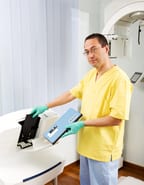Open MRI Scan
 Magnetic resonance imaging, also known as MRI, is a non-invasive, radiation-free scanning technology that uses radio waves and magnetic fields to produce clear and detailed three-dimensional images of organs and hard and soft tissues throughout the body. While a safe and effective diagnostic test, an MRI can be intimidating to some patients because it requires that the patient be enclosed in a narrow tunnel for the duration of the procedure, typically 30 minutes to 1 hour. The open MRI offers an option for the same accurate imaging without the confinement that some people find disturbing. Open MRI scans are not available at all testing locations
Magnetic resonance imaging, also known as MRI, is a non-invasive, radiation-free scanning technology that uses radio waves and magnetic fields to produce clear and detailed three-dimensional images of organs and hard and soft tissues throughout the body. While a safe and effective diagnostic test, an MRI can be intimidating to some patients because it requires that the patient be enclosed in a narrow tunnel for the duration of the procedure, typically 30 minutes to 1 hour. The open MRI offers an option for the same accurate imaging without the confinement that some people find disturbing. Open MRI scans are not available at all testing locations
Reasons for an Open MRI Scan
An open MRI scan, like all MRI scans, is multifunctional and can be used to identify or locate an injury or abnormality, scan for developing problems, analyze damage from previous trauma, or aid in the planning of surgery. During an open MRI, radio waves detect differences in water concentration in various body tissues, and in so doing can detect abnormalities that cannot be found with other procedures.
An open MRI scan produces images of any area of the body and can be an invaluable tool for detecting and diagnosing the following conditions:
- Tumors and cancer
- Eye and inner ear disorders
- Infections
- Neurological disorders
- Dementia or stroke
- Pituitary gland disorders
- Back pain, spinal cord injury, herniated disk, pinched nerve
- Heart or vascular disease
- Joint and musculoskeletal disorders
An open MRI scan can be used to view and assess the anatomy and functioning of major organs, including the heart, lungs, liver, kidney, spleen, pancreas, and reproductive organs. It is especially effective in detecting tumors of the brain, meninges and pituitary gland.
Benefits of an Open MRI Scan
While all MRIs are safe and noninvasive, people with claustrophobia or other anxieties often feel uncomfortable in a traditional MRI unit because they must lie still inside a narrow tunnel and listen to the loud banging sounds the machine emits. Unlike traditional MRI machines, which resemble long tubes, open MRI machines are patient-friendly with a more accessible structure. Because the patient is only partially enclosed, the procedure is quieter, more comfortable, and less anxiety-producing. Patients are also permitted to have a friend or family member in the room with them during an open MRI procedure.
The Open MRI Scan Procedure
Patients are advised remove all metal objects, including jewelry, eyeglasses, and hair clips, prior to the procedure, as these may interfere with the magnetic field of the unit. In some cases, the patient may be injected with a contrast dye to better delineate certain inner regions of the body during the test. While undergoing the open MRI scan procedure, the patient lies still on a table that slides under the MRI unit. The sides of the unit are open; the scanning units remains above and below the patient.
While the patient lies still, a series of scans, using a combination of magnetic fields and radio frequencies, produces the necessary images. These images are projected onto a computer screen and can then be printed for future analysis.
Risks of an Open MRI
An open MRI is considered a safe diagnostic procedure with no major risks for most patients, but its strong magnetic field can, under certain circumstances, lead to serious complications. An open MRI exam is not recommended for patients with:
- Cardiac pacemakers
- Implantable cardioverter defibrillators
- Cochlear implants
- Intrauterine devices
- Metal implants
- Surgical staples
Open MRI scans are not recommended for women who are pregnant or breast-feeding. Patients should discuss all health conditions with their doctors before undergoing an open MRI scan. If an MRI scan is prescribed for a patient for whom anxiety is a known problem, the patient should be proactive about being referred to a location where an open MRI scan is available.
